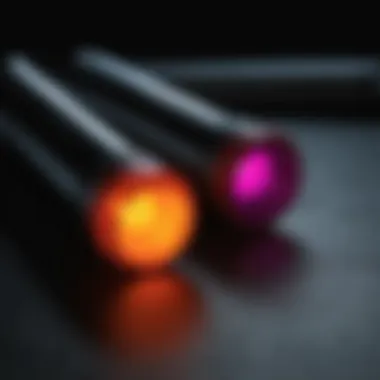Unveiling the Intriguing Power of Black Light Technology for Detecting Stains: A Deep Dive


Rock and Fossil Identification
When it comes to unveiling the power of black light for stains, understanding the intricacies of rock and fossil identification is crucial. Different types of rocks and fossils exhibit distinct characteristics that can help in stain detection. It's essential to look for specific features such as fluorescence patterns or texture variations under black light to pinpoint potential stains. Utilizing tools like magnifying glasses and ultraviolet lamps can aid in a detailed examination of rocks and fossils for hidden marks.
Detection Techniques
In the realm of stain detection using black light, various techniques can be employed to enhance the process. Differentiating between natural fluorescence in rocks and spots of contamination can be challenging but pivotal. By studying the intensity and color of fluorescence emitted by rocks and fossils, one can discern between normal patterns and possible stains with accuracy. Additionally, using filters or polarizing lenses with the black light source can further refine the detection process by amplifying specific fluorescence wavelengths or reducing background interference.
Forensic Applications
In forensic investigations, the application of black light technology for stain detection holds significant importance. From crime scene analysis to identifying bodily fluids on various surfaces, black light plays a crucial role in unveiling hidden clues. By utilizing specialized luminol reagents in conjunction with black light sources, forensic experts can reveal bloodstains or other elusive substances that are not visible to the naked eye. This meticulous process aids law enforcement agencies in gathering vital evidence for solving criminal cases.
Practical Considerations
Practical considerations when using black light for stain detection involve proper calibration and maintenance of equipment. Ensuring that the black light source emits the optimal wavelength for revealing stains is essential for accurate detection. Regularly checking and replacing UV bulbs and filters within the light source can prevent inconsistencies in fluorescence readings. Moreover, understanding the limitations of black light technology, such as its inability to penetrate certain materials or detect transparent stains, is essential for conducting thorough stain inspections.
Conclusion
Introduction to Black Light Technology
In delving into the world of utilizing black light for detecting stains, the Introduction to Black Light Technology plays a crucial role in providing a foundational understanding of this innovative technology. It sets the stage for exploring the nuances of black light and its application in stain detection. By grasping the basic principles behind black light, readers can comprehend its significance in various settings, from residential spaces to forensic investigations. Understanding the specific elements of black light technology, such as its ability to reveal hidden substances under specific conditions, can enhance the effectiveness of stain detection methods.
Understanding the Science Behind Black Light
Properties of Ultraviolet Light
Ultraviolet light, a key component of black light technology, possesses unique properties that make it an indispensable tool for stain detection. Its short wavelength allows it to fluoresce certain substances, making them visible under black light. This characteristic is particularly beneficial in detecting stains that are otherwise imperceptible to the naked eye. Despite its advantages in revealing hidden marks, the exposure to UV light must be managed carefully to prevent any potential risks associated with prolonged exposure.


How Black Light Differs from Regular Light
Black light differs from regular light due to its specific wavelength range that falls outside the visible spectrum. This unique feature enables black light to illuminate fluorescent materials that may go unnoticed under normal lighting conditions. By harnessing this distinct quality, black light aids in uncovering traces of substances that would otherwise remain concealed. While the use of black light enhances the detection of stains, it is essential to be aware of the limitations it presents, such as the need for proper dark environments to optimize its effectiveness.
Historical Insights on Black Light Usage
Early Discoveries and Innovations
The historical perspective on black light usage provides valuable insights into the evolution of this technology for stain detection. Early discoveries and innovations surrounding black light paved the way for its applications in various fields, from art restoration to forensic analysis. By examining the roots of black light usage, we gain a deeper appreciation for the versatility and impact of this technology in uncovering hidden substances and marks. Understanding the historical context of black light usage enhances our comprehension of its current relevance and potential for further advancements in stain detection techniques.
Applications of Black Light in Stain Detection
The section on Applications of Black Light in Stain Detection delves deeply into the pivotal role of utilizing black light technology to detect hidden stains across various settings, ranging from residential spaces to forensic investigations. This section serves as the cornerstone of the article, shedding light on the significance, precision, and versatility of black light in identifying elusive substances.
Residential Use of Black Light
Identifying Pet Stains
Exploring the realm of Identifying Pet Stains under the Residential Use of Black Light uncovers a crucial aspect of stain detection within homes. This subtopic specifically focuses on the detection of pet-related stains, a prevalent concern for pet owners seeking to maintain a clean environment. The key characteristic of Identifying Pet Stains lies in its ability to pinpoint specific areas contaminated by pets, facilitating effective cleaning and odor elimination. This method is highly advantageous in residential spaces, offering pet owners a reliable strategy to address hygiene issues promptly. However, one potential disadvantage of Identifying Pet Stains is the need for thorough inspection to ensure all affected areas are identified.
Spotting Hard-to-Detect Spills
In the context of Spotting Hard-to-Detect Spills, this subtopic addresses the challenge of identifying and distinguishing spills that are difficult to detect with the naked eye. By utilizing black light technology, individuals can efficiently locate and address spills that may otherwise go unnoticed. The key characteristic of this method is its effectiveness in revealing hidden spills in various environments, enhancing the overall cleanliness and safety of spaces. Spotting Hard-to-Detect Spills is a popular choice for stain detection due to its ability to uncover imperceptible spills, contributing to thorough cleaning practices. Nevertheless, a minor drawback of this approach could be the requirement for repeated scanning to ensure all spills are identified accurately.
Forensic Applications of Black Light
Bloodstain Analysis
The section on Bloodstain Analysis within Forensic Applications of Black Light focuses on the critical role of black light technology in analyzing bloodstains at crime scenes. This specific aspect plays a key role in forensic investigations, aiding professionals in determining the presence and distribution of blood evidence. The primary benefit of Bloodstain Analysis lies in its ability to reveal blood spatter patterns and hidden blood traces with precision, assisting in crime scene reconstruction. This method is a popular choice in forensic settings due to its accuracy and reliability in identifying vital evidence. However, a potential limitation of Bloodstain Analysis is the need for skilled interpretation to draw accurate conclusions.


Detection of Trace Evidence
The exploration of Detection of Trace Evidence highlights the significance of utilizing black light technology to detect minute traces of critical evidence in forensic scenarios. This aspect contributes substantially to the overall goal of enhancing forensic investigations through meticulous examination of trace materials. The key characteristic of Detection of Trace Evidence is its capacity to unveil subtle clues and materials that may otherwise remain unnoticed, aiding investigators in piecing together crucial information. This method is highly beneficial in forensic contexts, providing valuable insights into complex cases. Despite its advantages, one possible disadvantage of Detection of Trace Evidence is the requirement for specialized training to interpret findings accurately, ensuring the reliability of investigative outcomes.
Choosing the Right Black Light Device
When embarking on the journey of selecting a black light device, considerations go beyond mere functionality. Two primary types of black light sources stand out: Fluorescent Tubes and LED Black Lights, each offering distinct advantages and considerations.
Types of Black Light Sources
Fluorescent Tubes: A Deep Dive
Exploring Fluorescent Tubes reveals a key component in black light technology. Known for their ability to emit ultraviolet light, Fluorescent Tubes are a popular choice due to their efficiency and longevity. The key characteristic of Fluorescent Tubes lies in their ability to produce a consistent and powerful UV light output, essential for effective stain detection. However, it is crucial to note that Fluorescent Tubes may have limitations in terms of size and portability, factors to consider when selecting a black light device for varying environments.
LED Black Lights: Shedding Light on Innovation
Conversely, LED Black Lights offer a modern twist to black light technology. With their compact size and energy efficiency, LED Black Lights have gained prominence in stain detection applications. The key characteristic of LED Black Lights is their versatility and focused UV output, providing targeted illumination for accurate stain detection. However, some may argue that LED Black Lights could have limitations in terms of intensity compared to Fluorescent Tubes, highlighting the importance of assessing the specific requirements of the intended application.
Factors to Consider Before Purchasing
Wavelength and Intensity: Illuminating the Importance
Wavelength and intensity play a crucial role in the effectiveness of black light devices for stain detection. The wavelength determines the type of stains that can be detected, with shorter wavelengths being suitable for certain substances while longer wavelengths have different applications. Intensity is equally vital as it determines the brightness of the UV light emitted, impacting the visibility of stains in various environments. Balancing wavelength and intensity is key to choosing the right black light device tailored to the specific staining agents being investigated.
Portability and Durability: Weighing Practical Considerations
Portability and durability are essential factors to contemplate before purchasing a black light device. For on-the-go stain detection tasks or fieldwork, a portable device enhances convenience and flexibility. However, durability is equally important, ensuring the longevity and reliability of the device for prolonged use. Finding a balance between portability and durability is crucial, especially when considering the intended frequency and conditions of use.


Best Practices for Using Black Light for Stain Detection
In the realm of stain detection, adhering to best practices is paramount for accurate and effective results. The utilization of black light technology in identifying stains requires a meticulous approach to ensure optimal outcomes. By following established protocols and guidelines, users can enhance the efficiency and reliability of stain detection processes. These best practices encompass various aspects such as proper preparation, thorough observation, and precise interpretation of findings.
Optimizing Lighting Conditions
Dark Environment Requirements
Dark environment requirements play a pivotal role in optimizing the efficacy of black light for stain detection. Creating a dark environment serves to maximize the fluorescence effect exhibited by stains under black light. The absence of external light sources ensures better contrast and clarity, allowing even subtle stains to become more visible. This controlled setting enhances the sensitivity of the detection process, enabling users to spot stains that may otherwise go unnoticed in well-lit conditions. While dark environment requirements may seem restrictive, they are essential for harnessing the full potential of black light technology in revealing stains.
Interpreting Findings Correctly
Distinguishing Between Types of Stains
A critical aspect of using black light for stain detection is the ability to accurately distinguish between different types of stains. Various substances exhibit distinct fluorescence characteristics when exposed to black light. By understanding these differences, one can differentiate between biological fluids, chemicals, and other substances based on their unique fluorescence patterns. Proper training and knowledge in stain identification are essential for interpreting findings correctly and drawing accurate conclusions. Distinguishing between types of stains not only aids in determining the nature of the substance present but also influences the subsequent actions required for remediation or analysis. Developing expertise in discerning the nuances of stain fluorescence is key to leveraging black light technology effectively.
Safety Precautions When Using Black Light
When delving into the realm of black light technology, it is crucial to emphasize the significance of safety precautions to ensure optimal utilization and to prevent potential risks. Safeguarding oneself and others from any harmful effects is paramount when harnessing the power of black light for stain detection. By adhering to essential safety measures, users can fully appreciate the benefits of utilizing black light devices in various settings.
Protecting Eyes and Skin
In the context of using black light for stain detection, protecting the eyes and skin is of utmost importance to avoid potential UV exposure risks. Exposure to ultraviolet light emitted by black lights can have adverse effects on the eyes and skin if not handled with care. Implementing protective measures such as wearing UV-blocking eyewear and covering exposed skin areas can significantly reduce the chances of experiencing any negative impacts from prolonged exposure to black light sources.
UV Exposure Risks
UV exposure risks associated with black light usage revolve around the potential harm that ultraviolet light can pose to the eyes and skin. The specific wavelengths emitted by black light devices can be harmful when directly exposed to the eyes, leading to possible damage if precautions are not taken. Understanding the risks involved and taking necessary steps to protect oneself from UV exposure is key to ensuring a safe and effective experience when using black light for stain detection.
Proper Handling of Black Light Devices
Apart from safeguarding the eyes and skin, proper handling of black light devices is essential to mitigate any risks during usage. Implementing preventive measures when handling black light equipment not only enhances safety but also prolongs the lifespan of the devices, ensuring consistent performance over time. By following recommended guidelines for handling and storing black light devices, users can maximize their effectiveness while minimizing the potential for accidents or malfunctions.
Preventive Measures
Preventive measures encompass a range of practices aimed at maintaining the integrity and functionality of black light devices. From ensuring secure transportation to proper storage when not in use, these measures help reduce the likelihood of physical damage or operational issues. By integrating preventive measures into regular maintenance routines, users can uphold the quality and reliability of their black light devices, optimizing their performance for efficient stain detection purposes.







